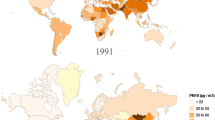Abstract
Data recovery is important in environmental modeling because of its multifaceted challenges that includes technical know-how, climate change, poor instrumentation analysis, and the integration of non-uniform systems. Aerosol optical depth data set from 2000 to 2013 was obtained from the Multi-angled Imaging Spectro-Reflectometry (MISR). The Auto-regression Moving Average (ARMA) was used to recover and predict the aerosol optical properties of 2014–2016 and 2017–2020, respectively. The third-order polymeric curve-fitting were used to synchronize the yearly average and the ARMA results. The output of the statistical experimentation showed high level of accuracy. Hence, this technique can be applied to environmental studies of air, noise, and water pollution.










Similar content being viewed by others
References
Brockwell P, Davis R (2009) Time series: theory and methods. Springer, Heidelberg
Chen B, Choi J, Escanciano JC (2017) Testing for fundamental vector moving average representations. Quant Econ 8:149–180. https://doi.org/10.3982/QE393
Dudek AE, Hurd H, Wójtowicz W (2016) Periodic autoregressive moving average methods based on Fourier representation of periodic coefficients. WIREs Comput Stat 8:130–149. https://doi.org/10.1002/wics.1380
Emetere ME, Akinyemi ML (2017) Documentation of atmospheric constants over Niamey, Niger: a theoretical aid for measuring instruments. Meteorol Appl 24(2):260–267
Emetere ME, Akinyemi ML, Akinojo O (2015a) Parametric retrieval model for estimating aerosol size distribution via the AERONET, LAGOS station. Environ Pollut 207:381–390
Emetere ME, Akinyemi ML, Uno UE (2015b) Computational analysis of aerosol dispersion trends from cement factory. In: IEEE proceedings 2015 international conference on space science and communication, pp 288–291. https://doi.org/10.1109/iconspace.2015.7283768
Emetere Moses E, Akinyemi ML, Oladimeji TE (2016) Statistical examination of the aerosols loading over Kano-Nigeria: the satellite observation analysis. Sci Rev Eng Environ Sci 72:167–176
Escanciano JC, Lobato IN, Zhu L (2013) Automatic specification testing for vector autoregressions and multivariate nonlinear time series models. J Bus Econ Stat 31:426–437
Ge M, Kerrigan EC (2016) Short-term ocean wave forecasting using an autoregressive moving average model. In: UKACC 11th International Conference on Control (CONTROL), Belfast, 2016, pp 1–6. https://doi.org/10.1109/control.2016.7737594
Hansen J, Sato M, Ruedy R (1997) Radiative forcing and climate response. J Geophys Res 102:6831–6864
Ives AR, Abbott KC, Ziebarth NL (2010) Analysis of ecological time series with ARMA(p, q) models. Ecology 91:858–871
Jacobs PA, Lewis PAW (1977) A mixed autoregressive moving average exponential sequence and point process EARMA(1,1). Adv Appl Probab 9:87–104
NASA (2018). Aerosols and incoming sunlight (direct effects). https://earthobservatory.nasa.gov/Features/Aerosols/page3.php
Ohata Sho, Moteki Nobuhiro, Mori Tatsuhiro, Koike Makoto, Kondo Yutaka (2016) A key process controlling the wet removal of aerosols: new observational evidence. Sci Rep 6:34113
Ramachandran S, Kedia S, Sheel V (2015) Spatiotemporal characteristics of aerosols in India: observations and model simulations. Atmos Environ 116:225–244
Shi S, Wu Z, Liu F, Fan W (2016) Retention of atmospheric particles by local plant leaves in the Mount Wutai scenic area, China. Atmosphere 7:104
Shunsuke N (2004) http://chem.atmos.colostate.edu/shun/research.htm. Accessed 11 Sept 2015
Sun WY, Yang KJS, Lin NH (2013) Numerical simulations of asian dust-aerosols and regional impacts on weather and climate- Part II: PRCM-dust model simulation. Aerosol Air Qual Res 13:1641–1654
Zhao DF, Buchhol A, Kortner B, Schlag P, Rubach F, Fuchs H, Kiendler-Scharr A, Tillmann R, Wahner A, Watne ÅK, Hallquist M, Flores JM, Rudich Y, Kristensen K, Hansen AMK, Glasius M, Kourtchev I, Kalberer M, Mentel TF (2015) Cloud condensation nuclei activity, droplet growth kinetics and hygroscopicity of biogenic and anthropogenic secondary organic aerosol (SOA). Atmospheric Chem Phys Discuss 15:19903–19945
Zhou Y, Xing X, Lang J, Chen D, Cheng S, Wei L, Wei X, Liu C (2017) A comprehensive biomass burning emission inventory with high spatial and temporal resolution in China. Atmos Chem Phys 17:2839–2864. https://doi.org/10.5194/acp-17-2839-2017
Acknowledgements
The author acknowledges the partial sponsorship of Covenant University and University of Johannesburg. The author acknowledges the assistance from NASA to use their satellite data set. The author declares no conflict of interest.
Author information
Authors and Affiliations
Corresponding author
Rights and permissions
About this article
Cite this article
Emetere, M.E. Environmental Data Retrieval and Prediction Using the Auto-regression Moving Average and Polynomial Experimentation. Aerosol Sci Eng 2, 99–108 (2018). https://doi.org/10.1007/s41810-018-0027-3
Received:
Revised:
Accepted:
Published:
Issue Date:
DOI: https://doi.org/10.1007/s41810-018-0027-3




